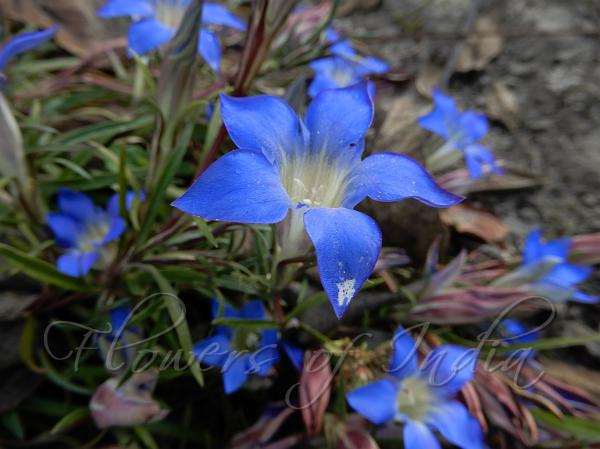|
| Himalayan Gentian |
|

|

| File size | 479032 |
| Original date | 10/28/19 6:10 PM |
| Resolution | 2048 x 1536 |
| Flash | Flash did not fire, auto |
| Focal length | 4.3mm |
| Exposure time | 1/40s |
| Aperture | 3.4 |
| Focus Distance | |
| Metering Mode | Center weighted average |
| Camera make | NIKON |
| Camera model | COOLPIX A900 |
| Sensor type |
|
|
|
|
Photo: |
Botanical name: Gentiana kurroo Family: Gentianaceae (Gentian family)
Himalayan Gentian is a critically endangered plant of the Himalayas.
Flowers are deep blue, paler in the throat and spotted with green and
white, usually two or more on each stem, but sometimes solitary. Flowers
are large, narrow funnel-shaped, up to 5 cm, with ovate pointed spreading
petals, and small triangular "lobules". Sepal cup is tubular, with narrow
linear petals 0.8-1.2 cm, 1/2-2/3 times as long as the sepal tube. Leaves
at the base are lanceshaped, ususally 10-12 cm. Stem leaves are 2-3 pairs.
Stems are several, 5-30 cm long, unbranched, arising from a stout
rootstock. Himalayan Gentian is found in the Himalayas, from Pakistan to
Uttarakhand, at altitudes of 1800-2700 m. Flowering: August-October.
Medicinal uses: The root of this plant has a long history of
use as a herbal bitter in the treatment of digestive disorders and is an
ingredient of many proprietary medicines. It is especially useful in
states of exhaustion from chronic disease and in all cases of debility,
weakness of the digestive system and lack of appetite. It is one of the
best strengtheners of the human system, stimulating the liver, gall
bladder and digestive system, and is an excellent tonic to combine with a
purgative in order to prevent its debilitating effects. It is taken
internally in the treatment of liver complaints, indigestion, gastric
infections and anorexia. It should not be prescribed for patients with
gastric or duodenal ulcers. The root is harvested in the autumn and dried
for later use.
The root of this plant has a long history of
use as a herbal bitter in the treatment of digestive disorders and is an
ingredient of many proprietary medicines. It is especially useful in
states of exhaustion from chronic disease and in all cases of debility,
weakness of the digestive system and lack of appetite. It is one of the
best strengtheners of the human system, stimulating the liver, gall
bladder and digestive system, and is an excellent tonic to combine with a
purgative in order to prevent its debilitating effects. It is taken
internally in the treatment of liver complaints, indigestion, gastric
infections and anorexia. It should not be prescribed for patients with
gastric or duodenal ulcers. The root is harvested in the autumn and dried
for later use.
Medicinal uses:
 The root of this plant has a long history of
use as a herbal bitter in the treatment of digestive disorders and is an
ingredient of many proprietary medicines. It is especially useful in
states of exhaustion from chronic disease and in all cases of debility,
weakness of the digestive system and lack of appetite. It is one of the
best strengtheners of the human system, stimulating the liver, gall
bladder and digestive system, and is an excellent tonic to combine with a
purgative in order to prevent its debilitating effects. It is taken
internally in the treatment of liver complaints, indigestion, gastric
infections and anorexia. It should not be prescribed for patients with
gastric or duodenal ulcers. The root is harvested in the autumn and dried
for later use.
The root of this plant has a long history of
use as a herbal bitter in the treatment of digestive disorders and is an
ingredient of many proprietary medicines. It is especially useful in
states of exhaustion from chronic disease and in all cases of debility,
weakness of the digestive system and lack of appetite. It is one of the
best strengtheners of the human system, stimulating the liver, gall
bladder and digestive system, and is an excellent tonic to combine with a
purgative in order to prevent its debilitating effects. It is taken
internally in the treatment of liver complaints, indigestion, gastric
infections and anorexia. It should not be prescribed for patients with
gastric or duodenal ulcers. The root is harvested in the autumn and dried
for later use. | Identification credit: Krishan Lal | Photographed in Kashmir & Sirmaur Distt, Himachal Pradesh. |
• Is this flower misidentified? If yes,